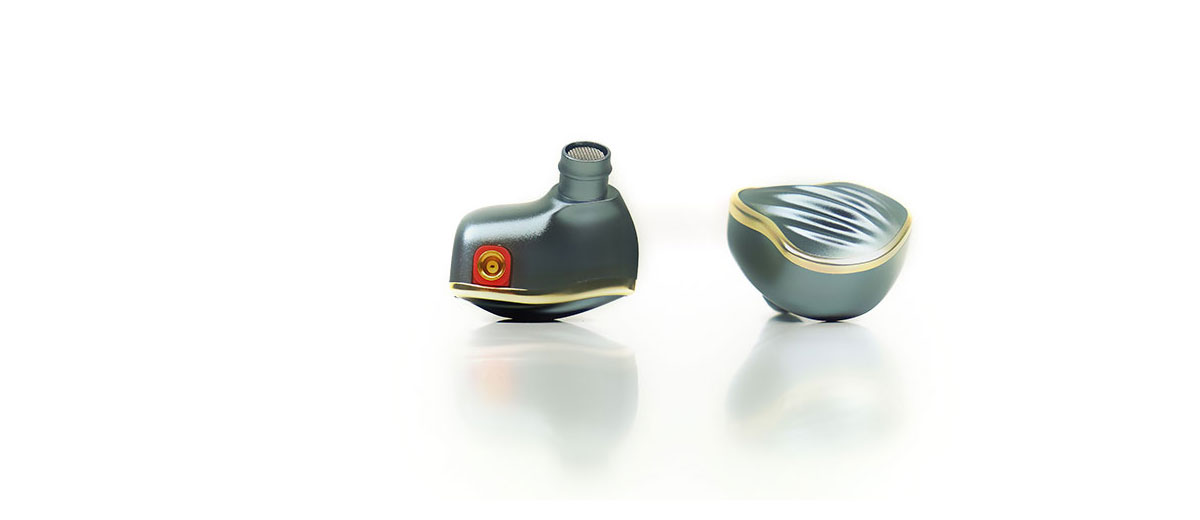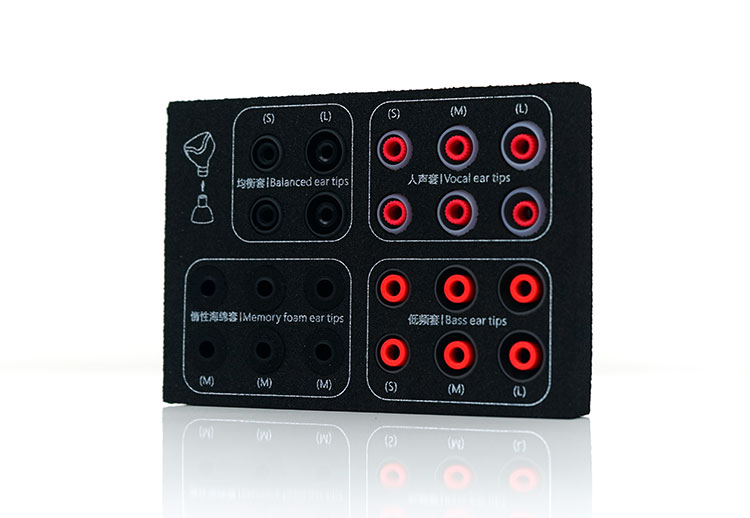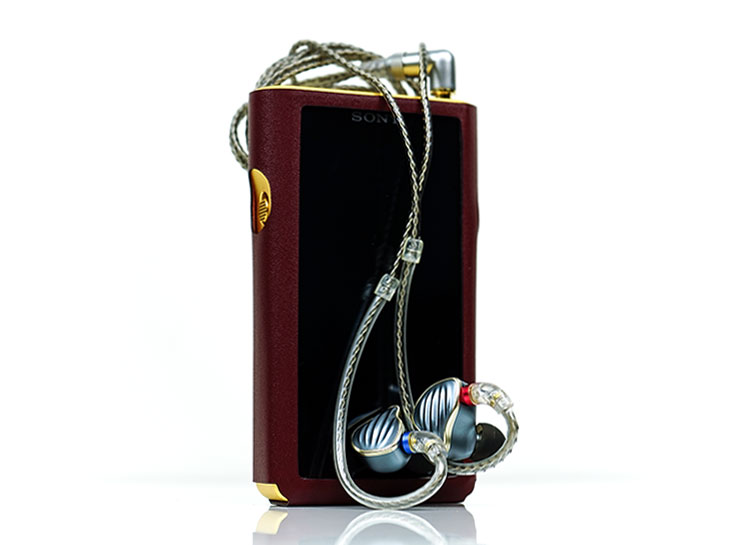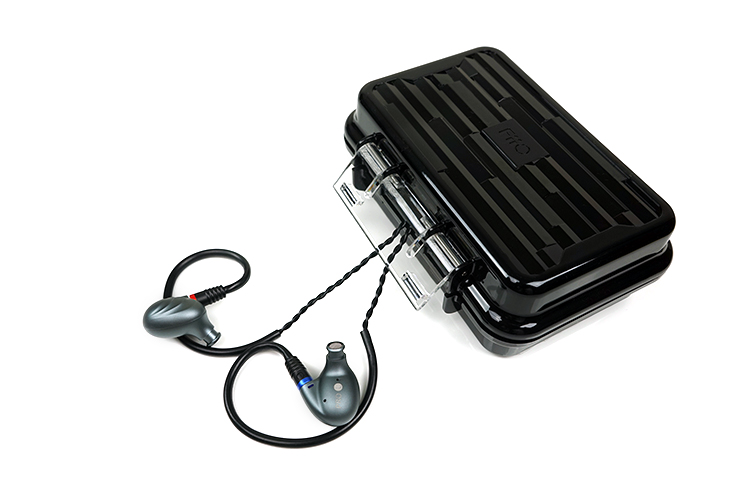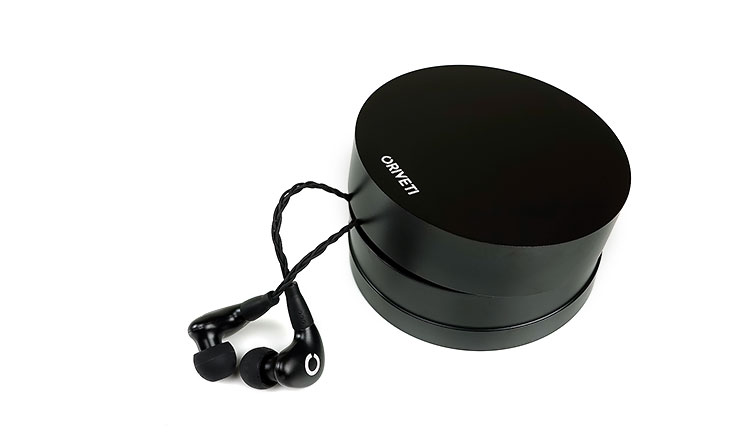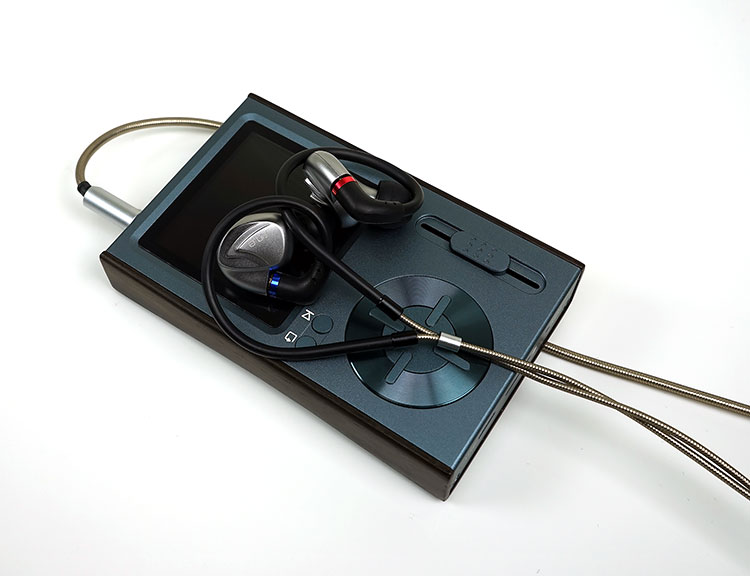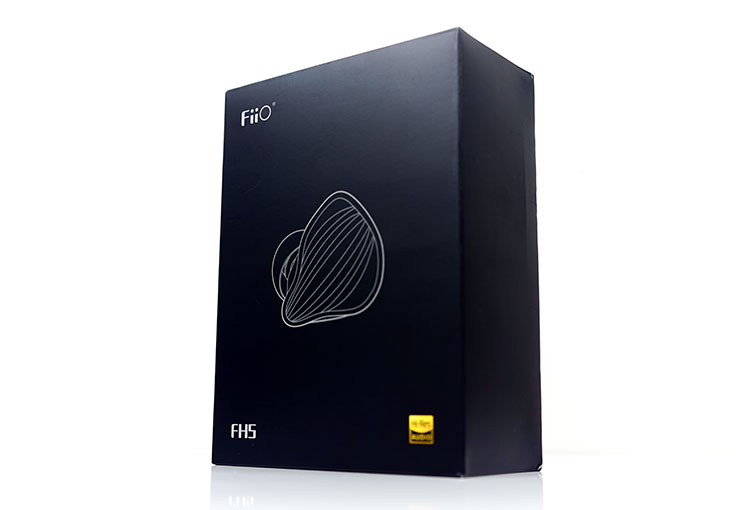Sound Impressions
Tonality & Presentation
The FH5 is not quite what I would define as a V-Shape because of that additional mid-range BA driver FiiO have stuck in. It makes a bit of a difference. This is more of a “W-shape” with a solid emphasis on sub-bass and vocals presence as well as a gentle peak and lift in the mid to upper treble.
The presentation for me is relatively balanced sounding on the whole with a tonality that is a little north of neutral in terms of warmth but otherwise quite natural sounding. At its high point, there is around an 8dB difference between the sub-bass peak around 50Hz and the most recessed part of the response curve at around 600-800HZ or the lower midrange.
The upper mids where the FR elevation is most prominent with a 10dB difference between it and the lower mids with a minor drop into the lower treble. The 7k bump on the FH5 is not overly prominent either but just enough so some perceptible clarity and contrast with the low-end warmth. Hence that relative balance I was talking about initially in the presentation description.
Staging
Staging on the FH5 has a bit more depth over height but it is not by any means a dark presentation. There is enough headroom and air, however, the upper treble presence is on the polite and relaxed side beyond 9-10k.
The FH5 is not particularly wide sounding but it images well, much better than the F9 Pro’s diffuse and vague mids. That midrange bump from 1-3k does push vocals and percussion presence fairly far forward. However, the lower mids dip keeps instrumental timbre a little leaner and cleaner as well as positioning them a little behind vocals preventing the staging from sounding congested.
Bass
The FH5 is more sub-bass than mid-bass focused with a peak of around 30-50Hz and then a slow but steady drop by around 8db into the lower mids around 600-800Hz. Mid-bass has some nice warmth but it plays second fiddle to the dynamic driver’s sub-bass presence and power.
However, FiiO’s low-end tuning of the FH5 is more tasteful than overpowering. It is unmistakably a dynamic driver with that slightly slower pace and natural levels of decay. Compared to a quad-BA driver with low-end equivalents such as the Noble Savanna, the FH5 bass performance is much more visceral, denser, and definitely more powerful sounding.
Mids
Mids on the FH5 are characterized by a fairly steep bump from 1-3k and a dip from around 600-800Hz. You will get a very forward upper mids presence on the FH5 by up to 10dB and vocals, especially mid to higher-pitched, will sound very forward and intimate.
Instrumental timbre is slightly north of neutral in terms of warmth but not overly rich and thick sounding. Positioning, particularly for lower midrange pitched instruments is a little behind the vocal presence so they are not in your face. Higher pitched instruments such as tambourines and cymbal work are much more forward and lively sounding. However, a slight FR dip post 3k to 5k keeps them from sounding splashing or abrasive.
The better vocal positioning also makes the FH5 much more amenable to pop and rock female vocals than the F9 Pro which sounded far more dipped and more suited to genres such as EDM which focus on the treble and low-end impact.
Treble
Treble on the FH5 is actually reasonably natural sounding with no particular emphasis. Yes, there is a slight nudge at 7k just for a bit of odd-harmonic presence in its percussion timber. However, the elevation is nothing sudden or too peaky so overall, I found it more on the relaxed side of things. Certainly, it is a huge step up on the bright and abrasive F9 treble with far less of a mid-treble peak.
There is a gentle but steady roll off-post-8k with a tiny nudge with that final BA tweeter around 10-12k for some welcome headroom and air. The articulation on the FH5 top-end is really good by the way. I never got a sense of being shortchanged on detail and clarity.
Tip Rolling
Balanced
Switching tips will alter the balance also. The stock balanced tips are ideal if you want to retain a reasonably accurate and true-to-tuning bass performance on the FH5. These are the black single silicone tips with fairly flexible stems. Despite my enjoyment of the vocal tips I tended to use the balanced for the majority of this review and beyond as they are the most balanced sounding.
Bass
The bass tips will do the trick if you want to maximize the bass response on the FH5 over the balanced tips. These are the smoked-colored and red stem silicone tips with the widest bore opening. Using these tips the FH5 mid-bass warmth will increase along with a little more sub-bass rumble. It will also smooth out the upper mids and lower treble a bit more creating a slightly darker sound.
Vocal
Switching to the vocal tips, which are characterized by a translucent head and very tight red stem, you will lose a bit of bass presence in favor of the mids and vocal presence. Now some might find that bias to be a little too much based on the already prominent stock tuning from 1-3k but personally, I quite enjoyed them.
My perception was a slight dip in the low-end as opposed to overdoing the mids so the positioning and elevation of the upper mids didn’t really change all that much. The lower treble also seemed a little more prominent than the bass and balanced tips.
Foam
In short, I did not like the FH5/foam combo at all which is unusual because I normally love foam tips. Overall, I felt the foams made everything sound a little muted, distant, and compressed sounding. It did not enhance the bass, in fact, it did a little of the opposite.
The foam tips also attenuated the mids presence and lopped a bit of the top-end sparkle. Quite a strange presentation for me with the FH5 and one that left me cold. Perhaps that’s why there is no label on them from FiiO as to what they do?
Matchability
Efficiency
The FH5 is actually fairly efficient and easy to drive, even more so than the F5, F9, and F9 Pro. Part of that is due to the better and larger drivers inside adding some additional layering and detail that can be picked up at lower volumes. The rest is simply down to improved sensitivity in the drivers FiiO has selected for the FH5.
The improved cable will also play a small role. I tend to find the cheaper cables such as the ones with the F9 to retain a higher level of resistance in the wire thus reducing the dynamic range potential of an IEM’s performance. Invariably, you start pushing up the volume with the F9 Pro to get more impact due to these factors and to a higher level than the FH5.
Synergy
As with most hybrid IEMs, I tend to find the dynamic driver performance does improve with decent amping. That is not to be confused with power or huge amping but just something with a bit more quality and decoding capability.
Dynamic Range
For example, two phones, an Onkyo Granbeat and an LG G6. Both initially sound very good, both have no issues on volume, and both sound tonally fairly close. However, on sustained listening, the Granbeat’s low-end shows of the better dynamic range between the two. This is a snappier sounding FH5 with a tighter bass response and sounding slightly more detailed. The LG G6 sounds a little softer and more compressed when paired with the FH5.
Pairing Preferences
In terms of tonality, it will largely come down to preference. I found a neutral or balanced sounding DAP with good headroom paired well with the FH5.
The FH5 really tends to perform better with modern rock and pop, it doesn’t have the chops to cover expansive classical sweeping scores due to its slightly limited staging performance. Thus, detail and clarity are important to me with the FH5, no matter what song you reference it with.
The likes of the AK240 worked well for me on this basis with its better levels of detail and slightly less low-end warmth but some might find it a little dry and brighter especially in the upper mids and treble.
Here, I would point you to the more reasonably priced but slightly less detailed consumer release, the M7 DAP from FiiO themselves. You get a nice full-sounding presentation though a slightly edgier upper mids and treble response than the AK240. It also has no problems driving the FH5 and delivers a very low noise floor.
If you want a bit more warmth and a more natural-sounding treble than the M7 then iBasso’s DX150 is an excellent pairing. The noise floor is a good match with Amp 6, it sounds impressively quiet with a black background and impressive dynamics when paired with the FH5.
Select Comparisons
FiiO F9 Pro
$139.99
Technical
The F9 Pro is a smaller-sized “entry-level” triple driver hybrid IEM and until the FH5 came out it was their TOTL IEM. You can still buy it, it is still a very good performer for the price point but honestly, it pales in comparison to the FH5 in both technical and performance.
The F9 Pro lacks that midrange BA driver and has the next tier down for the highs dual driver. The dynamic driver is the same composition just slightly smaller at 9mm versus 10mm on the FH5.
Sensitivity
The F9 Pro is rated at 28Ω and 106dB so it is a touch harder to drive and not as sensitive as the FH5. In real-world testing, we did have to push up the volume a bit more on the F9 Pro compared to the FH5.
On similar sources (FiiO X5ii and Sony W1MZ) the FH5 was also more lively and dynamic sounding than the F9 Pro. Both still perform well on high noise floors so not much in the way of background hiss and both very silent on the FiiO X5iii amp stage.
Build & Cable
The form factor and build on both are good but the FH5’s contours and deeper body feel sturdier and fits a little deeper without any discomfort. I find the FH5 to also isolate a bit better than the F9 Pro.
The MMCX connectors on the FH5 are angled better making it less of a pain to disconnect than the F9 Pro. Without a shadow of a doubt, the quality of the unbalanced cable on the FH5 is much better than the F9 Pro version. Note, the F9 Pro does come with a balanced cable which would have been nice to have seen included in the FH5 package.
Performance
The F9 Pro is truly v-shaped compared to the W-shaped FH5. The dynamic driver is still smaller though and it has no dedicated midrange BA driver. The whole presentation comes across as “smaller”, less engaging, and not as rich in detail as the FH5.
Tonally, the F9 Pro is also a lot cooler than the FH5 with a neutral instrumental timbre that lacks the same richness and body the FH5 is capable of delivering. Not that the FH5 is a fat-sounding IEM but the F9 Pro sounds a lot hollower and brittle in comparison.
Staging is narrower and imaging is more diffuse with lower mid instruments pretty far back from the stage, much more so than the FH5. Both have a forward vocal and midrange presence but the F9 Pro’s tonal balance is skewed somewhat but a big spike at 8-10k making it sound the sharper of the two.
You will hear much more sibilance and splashiness than the FH5 as a result of that spike. The FH5 tones down that area and at the same time sound airier and more detailed than the F9 Pro because of the dedicated better quality dual driver. The F9 Pro is simply pushed hard and further forward to give a “perception” of detail but it comes at the cost of a natural harmonic balance.
Oriveti New Primacy
$299
Technical
The New Primacy is a gen 2 triple driver hybrid IEM. It has a single 8mm dynamic driver for lows and mids and a dual driver BA design for the highs. At $299 it is becoming slightly less of a value proposition with the rash of new triple driver entry-level IEMs at almost half the price. Now with the cheaper FH5 quad-driver, it may have already seen better days on a technical level.
Build & cable
Still, there is much to be admired with a very smooth and well-built form factor that is very comfortable to wear and an excellent level of isolation. The range of tips is also excellent with the foam tips doing a better job sonically than the FH5 foam versions.
The accessory lineup is as good if not better than the FH5 with an 8-wire SPC cable that handles very well with low noise and no memory retention. You also get some added extras such as a quarter jack converter and airline adapter and detachable ear hooks.
Sensitivity
The Primacy is rated at 8Ω and 105db and whilst it is fairly easy to drive I find the FH5 marginally more responsive to volume changes and working a lot better using weaker sources and medium-powered DAPs. The FH5 though was quieter on the X5iii amp stage than the Primacy which could pick up the tiniest bit of background noise.
Performance
The Oriveti New Primacy is more aggressively dipped in the mids and fundamentally V-shaped in its presentation. Much like the F9 Pro, the New Primacy’s lack of midrange driver and smaller dynamic driver means that it sounds a lot “smaller” and less detailed than the FH5.
The mids are the most problematic area on the New Primacy. Well for me it is because it has a similar dip 2-5k dip to the IE800 FR and it is something I am not a big fan of. I will say though that I find it much improved and more coherent sounding than the older Primacy but that dip veils a lot of vocal presence and sucks the air out of the mids.
The FH5, on the other hand, has that 2-4k peak which is the total opposite of the Primacy. The FH5 dual driver design for the top-end delivers a much airier presentation and better harmonic balance also. That in combination with the forward upper mids delivers a lot more presence and clarity compared to the Primacy.
The low-end on the Oriveti is a little more sub-bass biased but the driver doesn’t have the same level of capability as the FH5 10mm driver. The low-end on the FH5 simply sounds deeper and more powerful and definitely more detail in its texture. It also helps in delivering a much more spacious and open presentation on the FH5.
Fidue A85 “Virgo”
$399
Technical
The Virgo is a mid-fi single dynamic and dual BA offering. It costs a little more than the FH5 which does not make a whole lot of sense in 2018 but maybe more logical last year. Time moves quickly and mercilessly for audio gear in some ways.
Build & Cable
The A85 is more F9 Pro in shape with a similar jellybean style and contoured front plate. Comfort and fit are on the same level as the F9 Pro and delivers a slightly easier fit than the F9 Pro but it is not as comfortable as the FH5 not does it seal as well.
It is a little too shallow for my liking meaning you do need a good tip to finish the seal off. It also has no lip on the nozzle so tips slide off real easily.
Both the FH5 and A85 use MMCX connections but given the awkward angle of the connectors on the shell of the A85, I tend it find it a little hard to change cables. Both have good quality 4-wire SPC cables with very next to no memory retention and microphonics. Comparatively speaking I think the FH5 cable is a little sturdier with stronger jacks and just the slightly quieter of the two.
Sensitivity
The A85 is rated at 20Ω and 107dB and just marginally the harder of the two to drive but not by much. In fact, jacked out of a FiiO X5iii in low gain we barely had to adjust the volume between the two to get similar loudness levels. They will pretty much perform equally for gain and also for noise as in very low levels of hiss on the likes of the X5iii.
Performance
The A85 is marginally more neutral-sounding than the FH5 but like the FH5 it has a fairly pronounced upper midrange emphasis. However, the A85 is more n-shaped than W-shaped in its presentation. Both have a forward vocal presence but the FH5 has a better overall balance in its presentation for a wider range of rock, pop, and EDM genres which is where it excels.
Unlike the FH5, the A85 low-end does not have the same depth, texture, and impact. Its bass tuning bias though is on the same path as the FH5 with more sub-bass than mid-bass presence and similar slow dive into a recessed midrange.
However, the level of dB and texture across the low end is much lower on the A85 and it simply lacks a lot of power. Given its smaller driver that is not a surprise. The FH5 low-end is much more powerful with better layering and detail.
The big difference is really the mids and that additional midrange driver of the FH5. Again it is all about resolution and detail as well as how much upper treble presence the FH5 delivers. Higher pitched instruments and vocal timbre on the FH5 benefit from that its superior upper order harmonic presence. It introduces a little more clarity, a cleaner more accurate sounding timbre.
The A85 sounds reasonably natural and you do get a similar vocal positioning to the fore but in comparison to the FH5, both instrumental timbre and vocals sound a bit soft and veiled since it rolls off a bit more in its treble. The dual-driver BA design simply cannot deliver the same range of detail, airiness, and harmonic balance.
Our Verdict
It would be a bit of a captain obvious statement to say the FH5 is the best IEM FiiO has released to date. It clearly is a different league than the F9 Pro and F5 entry-level models and the much higher price logically suggests that also.
The most important aspect of the FH5 for me is the fact it makes relative competitors such as the New Primacy and A85 seem poor value and out of date already. These are hybrid triple drivers priced in the same bracket if not slightly higher released 12 months ago or less. Time moves on quickly so a quad-hybrid sub-$300 is excellent value but sonically the FH5 outguns these two rivals with room to spare.
Naturally, that upper midrange peak might put some off, others might want a more neutral sound and go quad-BA. Others, like me, would love to see a balanced version of that cable in the box just to know if things could get even better. These are points of preference and possible cost creep with the cable I guess. They are not deal-breakers.
For now, FiiO has set out their marker again with the FH5. It is a fantastic value for what you get, looks great, and fits very comfortably. Most importantly this is a very good hybrid driver IEM, ideally suited to modern rock and pop, which, in the end, is what it’s all about really.
FiiO FH5 Technical Specifications
| Driver type | 1 dynamic and 3 BAs (Knowles) |
| Frequency response | 15Hz ~ 40kHz |
| Sensitivity | 112 dB/mW |
| Impedance | 19 Ω |
| Plug | 3.5mm gold-plated L-shaped plug jack (CTIA standard) |
| Cord length | 1.2 m |
| Weight | 8g (single earbud) |
| Wearing type | Over the Ear |
| Detachable cable design | Yes (standard MMCX connector) |
| Max. input | 100mW |

